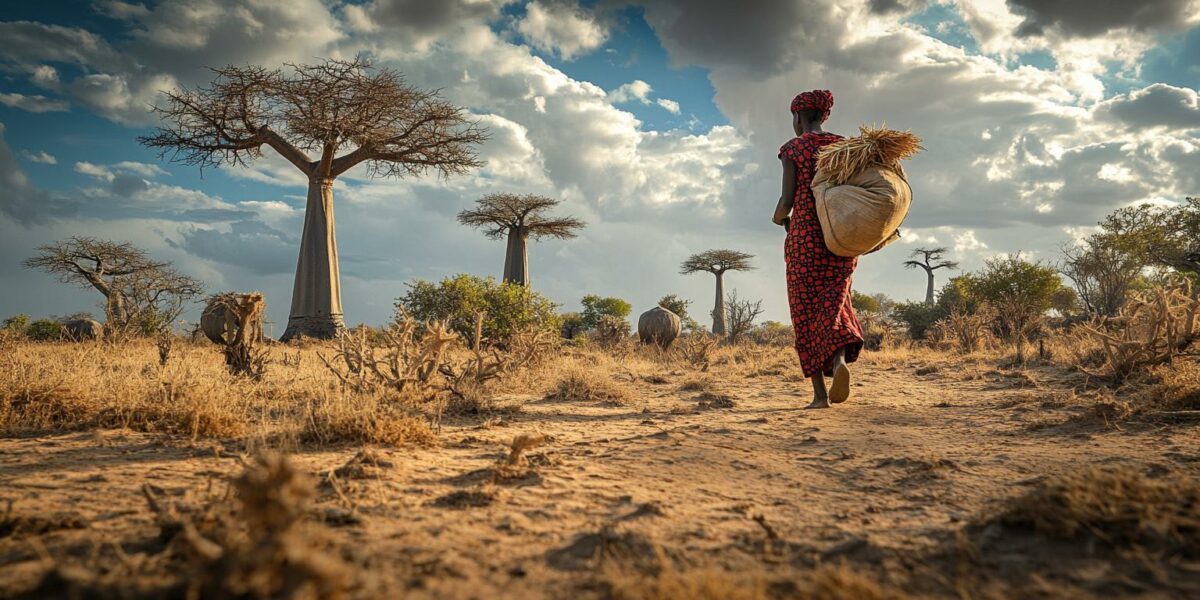The Unexpected Economic Lifeline of Baobab Trees
Loveness Bhitoni, a resident of Zimbabwe, has relied on baobab trees for sustenance since childhood. These gigantic trees have become a vital source of income for her as climate change devastates traditional crops. With the world’s demand for baobab fruit skyrocketing, Bhitoni’s foraging has turned into a daily grind for survival.
In her quest for baobab fruit, Bhitoni traverses harsh landscapes, facing the risk of wildlife encounters. She collects the hard-shelled fruit from these resilient trees, selling them to food processors or individual buyers. This trade, which began in 2018, has become a lifeline for locals in northeastern Zimbabwe.
Once a supplement for school fees and clothing, the baobab trade is now essential for Bhitoni’s survival. The recent El Niño-induced drought has made this trade even more crucial. “We can only afford corn and salt,” Bhitoni laments, highlighting the dire economic conditions.
Despite the booming global market for baobab products, the locals see little profit. The African Baobab Alliance estimates that over 1 million rural African women could benefit economically from this trade. However, the process remains challenging, with safety concerns and climbing hazards lingering.
Baobab: The Resilient Tree with Untapped Potential
Native to the African continent, the baobab tree is renowned for its resilience. Known as the “tree of life”, it can withstand severe conditions such as drought and fire. Zimbabwe alone boasts around 5 million baobab trees, providing a significant resource for local communities.
Despite its health benefits, the baobab fruit remained largely unnoticed outside Africa. Gus Le Breton, an industry pioneer, recalls the extensive regulatory and safety testing required to introduce baobab products to international markets. The fruit, rich in antioxidants, vitamin C, and essential minerals, faced initial skepticism abroad.
The U.S. and Europe legalized the import of baobab powder in the late 2000s. Convincing foreign consumers to embrace its sharp, tart-like taste was a challenge, but perseverance paid off. Today, baobab powder is a sought-after ingredient in health foods and beverages.
Baobab’s global market, projected to reach $10 billion by 2027, is driven by increasing demand in the U.S., Europe, and China. Major companies like Coca-Cola and Pepsi have incorporated baobab ingredients into their products, fueling the industry’s growth. The market is expected to expand, benefiting both rural and urban consumers.
Challenges and Hopes in the Baobab Trade
In Zimbabwe, a processing plant showcases the growing baobab industry. Baobab pulp is meticulously separated from seeds, with each bag tagged to trace the harvester. The hard shells are converted into biochar, aiding farmers with organic compost. Despite these advancements, harvesters like Bhitoni face significant challenges.
Foraging for baobab fruit is arduous work. Bhitoni spends hours walking through the sunbaked savanna, often returning with only a fraction of a sack. The fruit’s scarcity exacerbates the struggle, forcing locals to trade with individual buyers at unfavorable rates.
Individual buyers exploit the locals’ desperation, offering cornmeal in exchange for large quantities of baobab fruit. “People have no choice because they have nothing,” says local councilor Kingstone Shero, highlighting the community’s vulnerability.
- Exploitation by individual buyers
- Scarcity of baobab fruit
- Lack of negotiating power
Despite these challenges, there is hope for better prices as the market expands. Industry experts like Le Breton foresee significant growth, potentially leading to better earnings for harvesters. The government and organizations are also exploring partnerships to empower rural women and improve processing capabilities.
Preserving the Legacy of Baobab Trees
The baobab tree is more than just a source of income; it’s an integral part of African heritage. Bhitoni’s careful selection of fruit, leaving the smaller ones for wild animals, reflects an age-old tradition. This balance between human needs and nature’s demands is crucial for sustaining the baobab population.
However, the future of baobab trees is uncertain. Climate change and increasing demand pose significant threats. The trees take over 20 years to mature and produce fruit, making it imperative to protect and nurture them for future generations.
Efforts to educate and train locals on sustainable harvesting practices are essential. The African Baobab Alliance plays a vital role in promoting food safety and encouraging ground collection to minimize risks. These initiatives aim to safeguard both the harvesters and the trees.
As the global market for baobab products continues to grow, it’s crucial to ensure that the benefits reach those who depend on these trees the most. By supporting sustainable practices and fair trade, we can help preserve the legacy of the baobab tree for generations to come.



hudson_aurora
How long do baobab trees typically live, and are there any efforts to plant more of them?
lincoln_siren
Wait, Coca-Cola and Pepsi use baobab in their products now? That’s wild!
Theodore
Wow, I had no idea baobab fruit was in such high demand! Maybe I should start buying it to support the cause.
charles
Great article! Thanks for shedding light on such an important issue. 🙏
Grayson0
This is so sad. Why isn’t the local government doing more to protect these trees and the people who rely on them?
sadiegalaxy
What can we do to help preserve these ancient baobab trees? 🌳